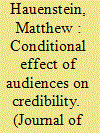| Srl | Item |
| 1 |
ID:
173897


|
|
|
|
|
| Summary/Abstract |
How do leaders signal their intentions during a crisis? Scholars point to audience costs, potential political punishment for bluffing during bargaining, to explain how accountable leaders communicate. However, the empirical support for audience costs is mixed. I argue that this apparent disconnect between theory and evidence is due to different ways that audiences can threaten to use their sanctioning power during a crisis. When determining whether to punish a leader for a failed coercive threat, their domestic supporters should balance concerns over consistency and policy outcomes. As such, accountable leaders’ ability to credibly communicate is not automatic, rather it depends on their supporters’ policy preferences. I apply this insight using casualty sensitivity as a conditioning policy preference. I expect, and find, that audiences only help a leader commit to fight when fighting is low-cost, and actually prevent commitment when fighting is high-cost. Using compellent threat data, I find that audiences have countervailing effects on credibility due to their preferences for leaders who are both consistent and avoid costly conflict. This conditional effect could explain prior mixed support for audience costs in observational data, as prior studies pool together instances where I find audiences have strong, but opposing, effects.
|
|
|
|
|
|
|
|
|
|
|
|
|
|
|
|
| 2 |
ID:
153950


|
|
|
|
|
| Summary/Abstract |
We propose a format for presenting experimental results that combines a graph’s strength in facilitating general-pattern recognition with a table’s strength in displaying numerical results. The format supplements a conventional bar graph with additional text labels and graphics but also can be based on a dot plot. The resulting enhanced bar graph conveys general patterns about treatment effects; displays point estimates and confidence intervals for all key quantities of interest relevant to testing hypotheses (e.g., first differences in the mean of the dependent variable); and clarifies the interpretation of these quantities as treatment effects. Presenting information in a single figure avoids the need to devote scarce journal space to both a graph and a table. Moreover, an enhanced bar graph prevents readers from having to move back and forth between a graph and a table of numerical results—thereby reducing their cognitive load and facilitating their understanding of the findings.
|
|
|
|
|
|
|
|
|
|
|
|
|
|
|
|